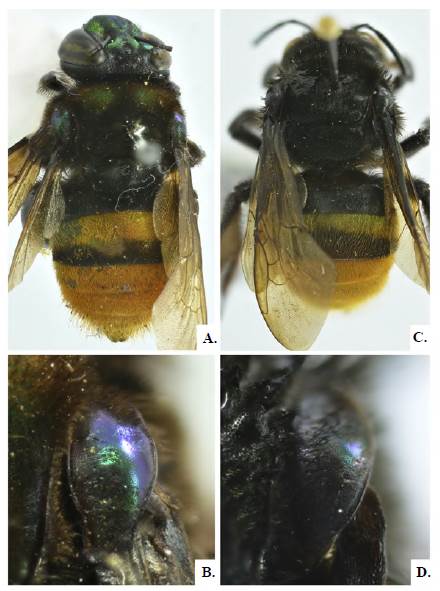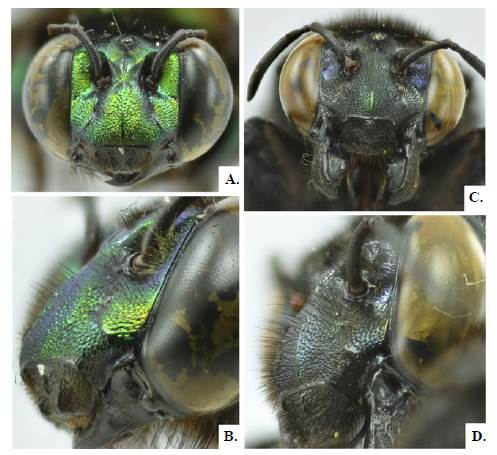Introduction
EufrieseaCockerell, 1908, is the second most diverse genus of the tribe Euglossini (Hymenoptera: Apidae: Apinae). The most recent list of species and synonyms of the genus was produced by Nemésio & Rasmussen (2011), who proposed a total of 66 valid names. After this work, Nemésio & Santos-Júnior (2013) described Eufriesea zhangi and González & Griswold (2017) described three new species more: Eufriesea engeli, Eufriesea barthelli, and Eufriesea oliveri (González, et al., 2017) thus completing 70 species registered for the genus.
Despite being the second most diverse genus of the tribe Euglossini, the high sea-sonality of its species, the frequent emergence in the high rainy season, and its long periods of diapause (Kimsey, 1982) makes Eufriesea a genus with few representatives in entomological collections (Nemésio, 2011).
The species Eufriesea dressleri (Kimsey, 1977) was described only based on male specimens (holotype and seven paratypes data: Male, Piña area, Canal Zone, Panama, V-18-1968 (R.L. Dressler, UCD)) due to the lack of female specimens. The original description also provided the diagnosis of the species and compared it with Eufriesea elegans (Lepeletier, 1841) given its similarity in the coloration patterns of the metasomal segments.
Bonilla-Gómez & Nates-Parra (1992) extended the geographical distribution of the species and reported it for the first time in the Orinoco region of Colombia. Their report, however, didn't include any coordinates data, or the record of the number of specimens found, nor the collections where the specimen were stored. Furthermore, Ramírez, et al. (2002) reported the presence of this species in the Orinoco region of Colombia and hypothesized its possible distribution in the Pacific Region of the country. The same document also mentioned that both sexes of the species were known and they were present in two biological collections: the Museu de Zoologia at the Universidade Federal do Paraná, Curitiba, Brazil (DZUP), and the University of Florida, Herbarium U.S.A (FLAS) suggesting that identifications of female specimens of Ef. dressleri had probably resorted to the original male-based description since the species of the '"elegans group" of Eufriesea do not show significant differences in the coloration patterns (other than the genitalia) between males and females of the same species.
It is also possible that Ef. dressleri females have been identified in other collections without an official description for the females of the species as happened with Eufriesea nigrohirta (Friese, 1899) (see Nemésio, 2005). However, the problem of the lack of a comprehensive description of the female persists, which may result in the misidentifica-tion of Ef. dressleri females or, conversely, that of females from similar species such as Ef. elegans misidentified as Ef. dressleri.
Methods
A total of 118 specimens of Eufriesea spp. from Colombian entomological collections were examined for this work: Colección Entomológica de la Universidad de Antioquia (CEUA) in Medellín (17), the Museo Entomológico Francisco Luis Gallego at Universidad Nacional de Colombia (MEFLG) in Medellín (97), and the Museo Entomológico de Piedras Blancas (MEPB) in Guarne (4).
As for the geographical data, the published information available to update the geographical distribution of species only provides the names of the departments or regions; therefore, to assign a location on the map, we selected the urban areas of these departments as reference points. For the material reviewed in the collections with no coordinates or height above sea level, we used digital elevation model (DEM) maps in the Qgis 3.10.4-A Coruña software to infer these data from the locality recorded on the labels. Inferred data appear in square brackets and the morphological terminology follows Kimsey (1982). We used a Leica EZ4 W stereomicroscope to describe the Ef. dressleri female.
Results
We found 11 species of Eufriesea out of the approximately 30 estimated for Colombia (Bonilla-Gómez & Nates-Parra, 1992; Ramírez, etal., 2002). The four species presenting new distribution ranges for the country included Ef. dressleri with three specimens, two of them females, used to describe the species allotype.
A male Ef. dressleri was identified from the material at the Museo Entomológico Francisco Luis Gallego (Figures 1A-B) collected by Francisco L. Gallego in 1949, in addition to a female (Figures 1C-D) from the same collection, which resembled the male in its coloration pattern; this specimen was, however, identified as Eufriesea aff. elegans by A. H. Smith-Pardo and was collected by the same entomologist in 1997 in Porce, Antioquia, Colombia. We also found a female in the CEUA collection, which was erroneously identified as Eufriesea pulchra (F. Smith) by L. Elorza.
In terms of the differences between Ef. dressleri and Ef. elegans, the latter has a tongue that reaches the second sternite (S2); when we studied the specimen identified as Eufriesea aff. elegans we found that it did not match this description and that its tongue only reached the midcoxa. Besides, we also observed differences in the metasomal coloration patterns, the body length, the integument coloration, as well as a variation in sculpture and shape of clypeus that made the specimen closer to the description of the Ef. dressleri male than to that of the Ef. elegans female.
Eufriesea dressleri (Kimsey, 1977)
Euplusia dressleriKimsey, 1977: 12
Material examined. 1 Male; Colombia, Antioquia, Turbo; [8°5' N, 76°43' W]; [5 m a.s.l]; ABR-1949; Francisco Luis Gallego, [leg]; Euplusia sp.; MEFLG NC 35923. 1 Female; Colombia, Antioquia, Porce, Santa Lucía P; [6°48' N, 75°08' S]; [860 m a.s.l]; AGO-12-1997; Jama; Allan Smith-Pardo. [leg]; Eufriesea aff. elegans, Allan Smith-Pardo [Det]; 10-12 hrs; MEFLG NC 34856 • 1 Female; Colombia, Antioquia, Puerto Nare, Vda Caño Seco, Hda La Brasilia; [6°12' N, 74°37' W]; 380 m a.s.l; OCT-09-2004; T. vannsommer; Castaño & Vélez [legs]; Eufriesea pulchra, Liliana Elorza [Det], SEP-30-2001; CEUA 16163.
Additionally, we reviewed photographs of the paratype of Eufriesea dressleri (Figure 2)
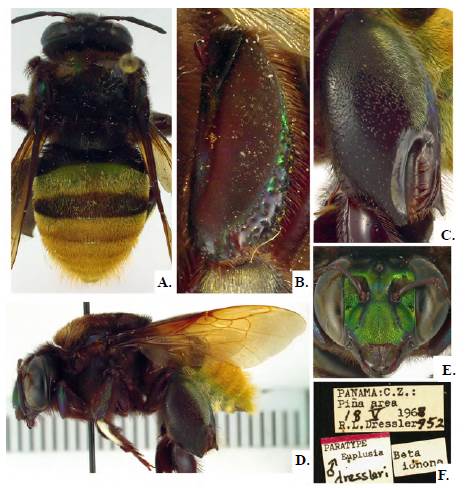
Figure 2 Paratype of Ef. dressleri. A. Dorsal habitus. B. Mid tibia. C. Hind tibia. D. Lateral habitus. E. Face. F. Labels.
Males:
Length = approx. 20 mm, maximum width of the mesosoma = 7.5 mm, length of the forewing = approx. 15 mm. Tegulae green (Figure 1B), face and clypeus green with slight coppery hues, covered with scattered brown setae, labrum black (Figure 3A) with green hues in lateral areas and brown setae scattered in the discal region and denser in the sides (Figure 3B), rest of the head black with black setae. Antennal depression with light yellow setae in the antenocular area. Mesoscutal patches green with light brown setae, rest of mesoscutum dark green to black covered with dark brown to black setae. Mesoscutellum black with green highlights and black short setae. Mesopleura entirely dark green with brown setae.
Description Female:
General color and vestiture. Clypeus dark green (Figure 3C), covered with scattered dark brown setae of different lengths (Figure 3D), some as long as the vertex setae. Labrum black with metallic highlights in the basal half and covered with dense dark brown setae of different lengths. The base of the mandibles black with light metallic highlights. Frons and vertex black with bronze hues, gena black with purple hues and dark brown setae, vertex with long black setae (2,5 ocellar diameter -OD-), frons, and vertex black with bronze hues and long black setae. Antennal depression with light brown setae on the antenocular area. Mesoscutum dark green, almost black, with dense black setae and bronze highlights. Mesoscutellum dark purple with bronze-green hues and black setae, setae longer in the distal half. Tegulae dark green with almost half black (Figure 1D). Mesopleura black with black setae. First terguite (T1) dark brown with black setae. T2 with the anterior half green with yellow hues covered with yellow setae and the posterior half copper with copper highlights covered with black setae. The first fourth of T3 red copper with yellow setae.
Last three-fourths of T3 to T6 bronze with yellow setae; T5 and T6 setae twice as long as T3 setae. S2 with basal two-thirds dark brown and covered with scattered yellow setae interspersed with some brown setae. Last one-third of S2 and S3-S6 with yellow setae. Setae on the sides of S6 longer and more erect than its discal setae.
Head. Clypeus with a thin ridge without puncture and two barely visible welts. Labrum with a ridge in the first basal third; maximum head width 6.5 mm. Upper inter-orbital distance = 3.1 mm, eye length= 4.3 mm, scape length= 1.8 mm, tongue in repose= 6.8 mm and reaching the midcoxa. Mandibles with four teeth, basal tooth very small and about half as wide as the second one. Epistomal suture under the tentorial pits strongly projected and forming a ridge (Figure 3D).
Body. Total length aprox. = 18 mm, maximum width of the metasoma = 7.6 mm, mesoscutellum = 4.3 mm wide and 1.8 mm long, anterior wing ca.=14.5 mm.
Punctation. Vertex with large rounded punctures, about 7 to 10 times the size of the micropunctures located in the circum-ocellar region. Punctures in frons of two different sizes, the smaller ones minute in relation to the larger ones. Clypeus with rounded punctures, integument between the epistomal suture and subantennal suture striated. Mesoscutum with dense punctures, of two sizes, the larger ones almost twice the size of the smaller ones, but more broadly distributed. Mesoscutellum with punctures of two sizes, larger ones almost three times the size of the smaller ones, distributed in equal proportions.
Male legs. Hind tibia black with a green stripe on the posterior margin and with a group of yellow setae appressed on the posterior margin (Figure 4A). Fore tibia and mid tibia brown with anterior side with strong hues (Figure 4B).
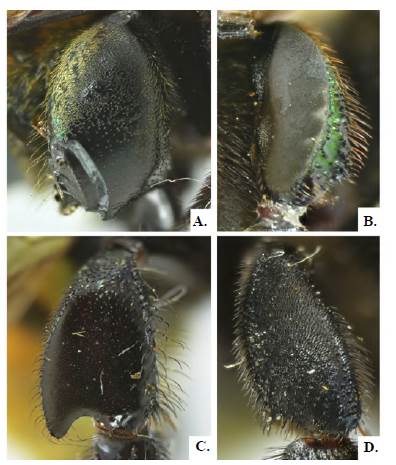
Figure 4 Legs of Ef. dressleri. A-B: Male legs: A. Hind tibia. B. Mid tibia. C-D. Female legs: C. Hindtibia. D. Midtibia.
Female legs. Hind tibia brown with minute yellow setae and metallic highlights in the basal area (Figure 4C). Maximum width of the hind tibia = 3.0 mm. Fore tibia and mid tibia brown with green and purple highlights on the outside (Figure 4D).
Diagnosis. This species is similar to Ef. elegans but can be distinguished because the length of the tongue does not exceed the midcoxa (in Ef. Elegans it reaches S2). Additionally, the posterior band of T2 occupies no more than the last two-thirds of the tergite, whereas in Ef. elegans it occupies three-quarters.
This species is also similar to Eufriesea eburneocincta (Kimsey, 1977) but can be distinguished by the black setae of T1 (pale yellow in eburneocincta) and by the color patterns of the bands of T2, which in Ef. dressleri has an anterior band green with yellow setae, whereas in Ef. eburneocincta the anterior band is brown with black setae and the posterior band is copper with orange-yellow setae.
Conservation status. The Red Book of Colombian Invertebrates (Amat-Garcia, et al., 2007) and Resolution 1912 of 2017 issued by the Colombian Ministry of the Environment place Ef. dressleri in the category of critically endangered (CR) species for Colombia.
Keys for elegans species group (females) adapted from Kimsey (1982)
1. Tongue in repose, reaching S2 or beyond.................................................................2
Tongue in repose, not reaching S2................................................................................ 3
2. First 1/4 of T2 green with yellow setae, last 3/4 of T2 brown coppery to black with black setae.............................................................................................elegans (Lepeletier)
First !4 of both T2 and T3 blackish or dark greenish with black setae, last % of T2 yellowish green to brassy with yellow setae.................................................duckei (Friese)
3. T2 banded, anterior half blackish with black setae, posterior half coppery to brassy with yellowish setae........................................................................eburneocincta (Kimsey)
T2 banded, anterior half brassy with yellow setae, posterior half brown to copper with blackish setae and some copper hues........................................................dressleri (Kimsey)
Extension of the distribution range of some Eufriesea species in Colombia: Eufriesea concava (Friese, 1899)
Euglossa (Eulema) mexicana concavaFriese, 1899
Material examined. 1 Male; Colombia, Antioquia, Porce, San Ignacio; [6°48' N, 75°08' S]; [860 m a.s.l]; AGO-29-1997; pescado; Allan Smith-Pardo, leg; Eufriesea aff. concava, Allan Smith-Pardo, Det; MEFLG NC 34835 • 5 Females; same data as for preceding, Picardía; OCT-01-1997; pescado; Allan Smith-Pardo, leg; rastrojo alto; Eufriesea concava, Allan Smith-Pardo, Det; MEFLG NC 34840, 34846, 34848, 34850, 34851 • 3 Females; same data as for preceding; OCT-09-1997; Jama; MEFLG NC 34844, 34855, 34863 • 1 Male; same data as for preceding; MEFLG NC 34857 • 1 Female; same data as for preceding; OCT-01-1997; MEFLG NC 34841 • 2 Females; same data as for preceding, Cancana; SEP-26-1997; MEFLG NC 34836, 34853 • 2 Females; same data as for preceding, San Ignacio; AGO-29-1997; Bosque; MEFLG NC 34838, 34847 • 2 Females; same data as for preceding, Tenche; OCT-03-1997; Jama; MEFLG NC 34839, 34849 • 1 Female; same data as for preceding; Escencia; OCT-10-1997; MEFLG NC 34845 • 1 Female; same data as for preceding; Normandía; Jama; OCT-30-1997; MEFFLG NC 34837 • 1 Female; same data as for preceding; pescado; SEP-18-1997; MEFLG NC 34854 • 2 Females; same data as for preceding; Fosforito; SEP-24-1997; MEFLG NC 34842, 34843 • 1 Female; same data as for preceding; La Calandria; OCT-31-1997; MFLG NC 34852 • 2 Males; Colombia, Antioquia, Ciudad Bolívar; 5°48'52'' N, 76°1'38" W; 1474 m a.s.l; SEP-26-2009; Eucaliptol; R.I Vélez leg; 10:00-12:00 hrs; Eulaema tropica, Allan Smith-Pardo, OCT-06-2009; MEFLG NC 35891, 35892 • 1 Female; Colombia, Santander, Cimitarra, Vda Primavera, Km4, Hda el Bosque; [6°18' N, 73°57' W]; [150 m a.s.l]; OCT-09-2001; VSR pescado; Castaño and Vélez [leg]; CEUA 18367 • 3 Females; Colombia, Risaralda, La Florida, Santuario de Flora y Fauna Otún Quimbaya; [4°44' N, 75°34' W]; [1900 m a.s.l.]; MAY- 05-2002; VSR Pescado; CO24; CEUA 116195-116197 • 1 Male; Colombia, Antioquia, Andes, Los Farallones; [5°39' N, 75°52' W]; 1800 m a.s.l; OCT-18-2014; Jama; J. Castro, leg; MEFLG NC 34879.
Ramírez, et al. (2002) proposed a possible distribution of Ef. concava (Figures 5A-B) in the Colombian Pacific and Amazon regions at a maximum altitudinal distribution of 1100 m.a.s.l., whereas Parra & Nates-Parra (2012) proposed distribution of this species in the departments of Amazonas, Chocó, Nariño, and Putumayo. The only report of this species for the country is by Smith-Pardo (1999) in his Master's degree thesis, which was unknown to the previous authors. The report was for Yolombó, Antioquia, at the altitudinal range mentioned by Ramírez, et al. (2002).
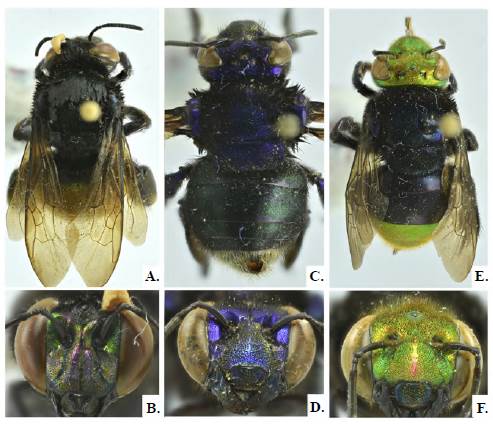
Figure 5 Dorsal and frontal habitus of Eufriesea spp. A, B. Ef. concava (male). C, D. Ef. magretti (female). E, F. Ef. pulchra (female)
Eufriesea dressleri (Kimsey, 1977)
Euplusia dressleriKimsey, 1977
Material examined. 1 Female; Colombia, Antioquia, Porce, Santa Lucía P; [6°48' N, 75°08' S]; [860 m a.s.l]; AGO-12-1997; Jama; Allan Smith-Pardo. [leg]; Eufriesea aff. elegans, Allan Smith-Pardo [Det]; 10-12 hrs; MEFLG NC 34856 • 1 Female; Colombia, Antioquia, Puerto Nare, Vda Caño Seco, Hda La Brasilia; [6°12' N, 74°37' W]; 380 m a.s.l; OCT-09-2004; T. van Sommer; Castaño & Vélez [legs]; Eufriesea pulchra, Liliana Elorza [Det], SEP-30-2001; CEUA 16163. 1 Male; Colombia, Antioquia, Turbo; [8°5' N, 76°43' W]; [5 m a.s.l]; ABR-1949; Francisco Luis Gallego, [leg]; Euplusia sp.; MEFLG NC 35923.
This species was reported in Colombia for the Orinoquía region by Ramírez, et al. (2002); Parra & Nates-Parra (2012) reported it for the departments of Meta (Orinoquía region) and Valle del Cauca (Pacific region).
Eufriesea magretti (Friese, 1899)
Euglossa (Eumorpha) magrettiFriese, 1899
Euglossa (Eumorpha) andina Friese, 1925 (Synonymy by Kimsey (1982))
Material Examined. 2 females; Colombia, Antioquia, Vereda el Carbono; 6°20' 38,8'' N, 76°07' S; 1879 m a.s.l; AGO-12-2007; Jama; A.L. Montoya G [leg]; CEUA 116199,116200. • 1 Female; Colombia, Santander, Carmen del Chucurí, Vereda Alto Cascajales; [6°41'53.84"N, 73°30'40.18" W]; 1200 m a.s.l; OCT-19-2000; VSR, Pescado; Duque y A. Vélez [leg]; CEUA 45053.
This species (Figure 5C-D) was reported for Colombia by Kimsey (1982) in the department of Magdalena. Ramírez, et al. (2002) indicated the presence of this species in the Atlantic and Orinoco regions while Parra & Nates-Parra (2012) confirmed Kimsey's record (1982) for the department of Magdalena and recorded it for the first time for Norte de Santander.
Eufriesea pulchra (Smith, 1854)
Euglossa pulchra Smith, 1854
Material examined. 1 Male; Colombia, Antioquia, San Luis; [6°02' N, 74°59' S]; [1080 m a.s.l]; DIC-1982; Eugenol; A. Molina P. [leg]; Eufriesea sp.; MEFLG NC 34870 • 1 Male; Colombia, Antioquia, río Cocorná; AGO-1982; Salicilato de metilo; Eufriesea pulchra, A. Molina P. [Det]; MEFLG NC 34869 • 1 Female; same data as for preceding, Porce; [6°48' N, 75°08' S]; [860 m a.s.l]; AGO-26-1997; pescado; Allan Smith-Pardo, leg; Eufriesea purpurata, Allan Smith-Pardo, Det; MEFLG NC 34866 • 1 Male; Colombia, Chocó, Nuquí, Finca Pjivá; [5°42' N, 77°16' S]; [0 m a.s.l]; JUL-09-2005; Manual; P. Duque [leg]; Eufriesea fasciata, Smith and González, 2006, [Det]; MEPB 9279 • 2 Males; Colombia, Antioquia, Sonsón, R.N Cañon del Río Claro; 350 m a.s.l; NOV-06-2007; Salicilato de metilo; A. Vélez [leg]; Eufriesea sp, J. Jaramillo Silva [Det]; MEPB 11624 - 11625 • 1 Male; same data as for preceding; San Luis, Cañon del Río Claro; 5°53'6,87'' N, 74°,5'4,88'' W; [890 m a.s.l]; NOV-06-2007; Salicilato de metilo; A. Vélez, N. Uribe And A. Vahos [legs]; CEUA 109357 • 1 Male; same data as for preceding; Anorí, El Roble, El Arrierito Antioqueño; 1600-1700 m a.s.l; 6°59'5,3'' N, 75°6'42,0'' W; MAY-25/27-2012; VSR pescado; En Bosque; CEUA 63731 • 1 Male; same data as for preceding; Jama; En Bosque; CEUA 63733 • 1 Female; Colombia, Antioquia, Puerto Nare, Vda La Mina; [6°12' N, 74°37' W]; 220 m a.s.l; SEP-2001; VSR; Castaño And Vélez [legs]; CEUA 116193 • 1 Female; Colombia, Risaralda, La Florida, Santuario de Flora y Fauna Otún Quimbaya; [4°44' N, 75°34' W]; [1900 m a.s.l]; MAY-07-2002; VSR Pescado; CO24 Cód; CEUA 116194.
Kimsey (1982), Fernández (1995), and Ramírez, et al. (2002) had pointed at the distribution of this species for the Amazon region, the latter adding the Orinoco region. Parra & Nates-Parra (2012) reported this species (Figure 5E-F) in the departments of Amazonas, Boyacá, Chocó, Guainía, Meta, Nariño, Valle del Cauca, and Vaupés.
Most of the records of Ef. pulchra are below 1000 m.a.s.l., only one specimen deposited in the Snow Entomological Collection from Tarata, Bolivia, collected in 1900, has a label with an altitude near 2800 m.a.s.l (Bentley, A. & Thomas, J., 2021). The location registered here for the facilities of the Otún Quimbaya Flora and Fauna Sanctuary has an altitude of 1900 m.a.s.l. However, it should be noted that the label did not have coordinates, so the height inferred for this place corresponds to the Sanctuary's hotel facilities, but within a 5 km radius from them, there are altitudes over 3100 m.a.s.l. Considering that species of this genus can travel up to 25 km in search of food and provisions for the nest (Janzen, 1971), this could be the greatest altitudinal record known for this species. For the time being, it is the highest altitude record of this species in Colombia.
In the present study, we report Ef. concava for the first time for the departments of Santander and Risaralda (Figure 6A) extending its distribution 230 km to the south and nearly 100 km to the east of the country. It also extends its altitudinal distribution to 1900 m a.s.l. Also, the three new records of Ef. dressleri herein correspond to the department of Antioquia (Figure 6B). These records extend Ef. dressleri range of distribution 525 km north of Colombia and constitute the first ones for the Andean region.
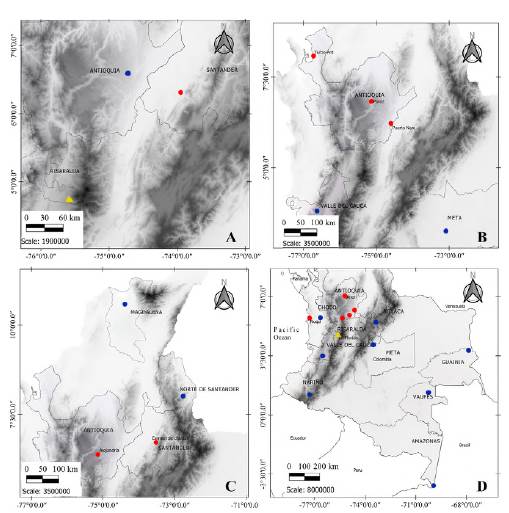
Figure 6 Distribution of species of Eufriesea in Colombia. Blue dots indicate literature reports, red dots are new records, yellow triangles represent new altitudinal distribution for the country. A. Ef. concava. B. Ef. dressleri. C. Ef. magretti. D. Ef. pulchra
Here we report Ef. magretti for the first time for the departments of Santander and Antioquia extending its range of distribution 320 km southwest of Colombia (Figure 6C). Besides, these new records increase its altitudinal distribution to 1879 m.a.s.l. Previously, Ramírez, et al. (2002) had registered an altitudinal distribution for the species of 1101600 m.a.s.l. As well as we report Ef. pulchra for the first time for the departments of Risaralda and Antioquia (Figure 6D) and extend its distribution 70 km west to the Pacific coast and 140 Km to the north of the country.
Discussion
Nearly 50% of the holotypes of Eufriesea are females. For 90% of these species, the association and description of males has been possible (Nemésio, 2005; Nemésio, 2011; Le Goff, 2012) thanks to the use of chemical compounds as attractants. On the other hand, only 65% of the species with a male as holotype has a description of females, which makes it difficult to identify Eufriesea spp. females overall and explains why many female specimens of this genus deposited in collections have no identification at species level.
Furthermore, the high seasonality of the species in this genus, as well as their sensitivity to changes in their ecosystem (Kimsey, 1982) and their scarce representation in collections (Nemésio, 2011) make it really difficult to be certain of accurate distribution ranges allowing for their exact location in the Neotropics.
We believe that more rigorous studies and revisions of the specimens deposited in collections worldwide, as well as further descriptions of undescribed females to allow successful associations between males and females of the same species are a fundamental tool to increase the knowledge of the diversity of this genus and that of the country's fauna by means of the construction of accurate distribution maps of the different species by using males and/or females for their plotting.














